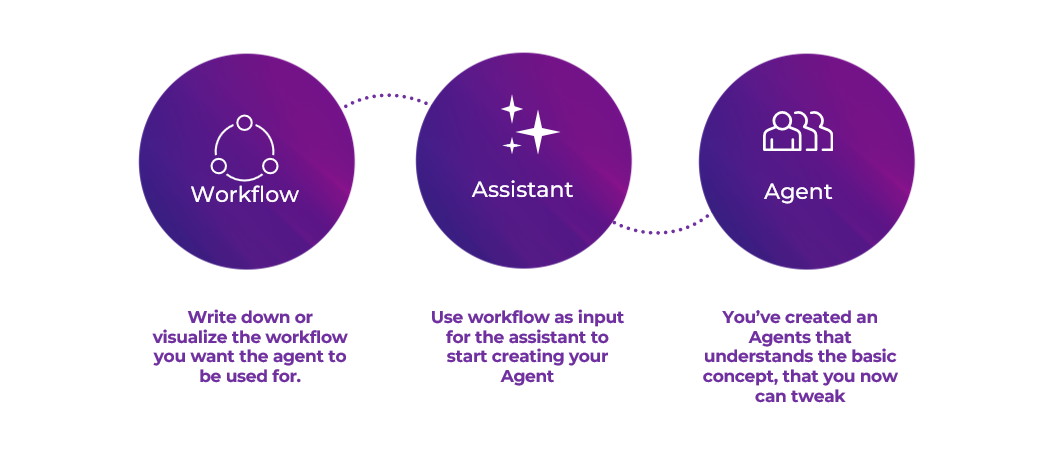Best Practices in HALO
Welcome to our best practices guide for creating and utilizing agents in Halo. This article highlights key strategies to ensure your agent development process is both efficient and effective.
Overview of Best Practices in HALO
Plan Your Workflow
Before you begin, thoroughly plan out the process in which your agent will be used. Map out the entire workflow and document it with images or text. This foundational work will help you design an agent that integrates seamlessly into your existing operations, promoting consistency and streamlining tasks.
Indicate the limitations of your Agents
Next to describing what your Agent can do, it is also considered best practice to describe what your agent cannot do. This helps the Agent become aware of at what moment the Agent should help the user, and at what moment the Agent should not help the user. Otherwise, the Agent will likely always try to help the user, even if that is not the intended purpose of the agent.
For example, let’s say you have an agent that handles checking order statuses, and its only behaviour are the instructions on how the handle checking order statuses. The Agent will not know how to handle any other types of other questions, and will likely try to help the user in any (unintended) way.
In this example, it would greatly benefit to simply add to the Agent: “For any inquiries unrelated to order statuses, [Breakout]”. Now the Agent knows what to do when it cannot help.
Maximize the Use of the Assistant
Leveraging the Assistant can greatly enhance the development of new agents and tools. Also, utilize visual aids and workflow diagrams to enhance the creation of new agents and tools. These resources simplify complex processes, offering powerful assistance as you develop and deploy your solutions.
Consult API Documentation
Always consult the API documentation of any software you intend to integrate. Providing this documentation to the assistant will ensure that your agents and tools communicate effectively with external systems, fostering better interaction and functionality.

Explore Tool Templates
Before creating a tool from scratch, check the tool template library for pre-existing tools that might fit your needs. Although not fully extensive yet, the library is growing continuously, offering you time-saving template options.
Secure API Keys
Manage your API keys efficiently by adding them to your Halo Profile's context. By setting them to private, you ensure added security. Retrieve these keys when needed by typing a forward slash (/) in your workflow, balancing accessibility with security.

Start Simple, Evolve Over Time
When designing agents, begin with simple processes. As your familiarity with the platform grows, progress to more complex agents. This phased approach builds your confidence and enhances your skills over time.
Configure "Handoff Only" Settings
Consider using the "handoff only" option for agents that don’t directly interact with users but rather generate inputs for another agent or serve as linking functions.
Improve Live-Agent Handover Consistency
Correctly Setup Your Root Agent
To improve consistency of handovers from HALO to Live-Agents, HALO has to be setup correctly. Utilising Breakouts within Agents is the go-to method for indicating to HALO that a query cannot be answered by the Agent. But in a multi-agent system, a breakout from the Non-Root Agent will result in the Root Agent handling the request next. Setting the Root Agent to also include breakouts and to be Handover Only may aid with this, as a breakout from the Root Agent implies HALO cannot answer the question, so we go into the Fallback Scenario, with a possible Live-Agent Handover. Handover loops will also trigger the Fallback Scenario. More information on Root Agents, Handovers and Handover Only mode are explained more in depth on the Agents page.
Using the Live Chat Handover Tool
It is also possible to use the Live Chat Handover Tool to directly enforce a handover to a Live Agent. To do this, use the following steps:
Import the Tool: Import the Live Chat Handover Tool from the tool templates in HALO.
Configure Parameters: Set up the tool with all relevant parameters (e.g., live chat platform, agent group, etc.).
Set Handover Type: In the Style Tab, change the Handover Type to "Live Chat Handover Tool."
Trigger from Any Agent: Use this tool to trigger handovers directly from any agent, including Non-Root Agents.
This approach eliminates the dependency on the Root Agent for handovers, providing more flexibility.
Break Down Tools
It can be beneficial to break down tools into smaller, specialised ones. This is especially helpful when separate API calls are required to gather input data for subsequent interactions.
E-learning Video
For further guidance, watch our e-learning video on best practices in HALO.
https://vimeo.com/1060535075/7b5bc0cbe8
